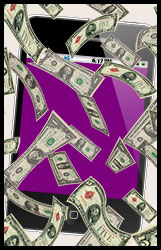Selling Your Old Tech
 Here’s a list of the most popular places to sell your old smart phones, tablets, laptops, etc. Each has certain advantages and rules. Check them out to find out which will work best for you.
Here’s a list of the most popular places to sell your old smart phones, tablets, laptops, etc. Each has certain advantages and rules. Check them out to find out which will work best for you.
Amazon is really better if you have a new piece of tech to sell – like a tablet or phone you ordered and never used. eBay is easy, so is Swappa. The last four are put in front of local folks only. Be sure to take some really good photos of what you’re selling – AFTER – you clean it up thoroughly. Tell the truth in your evaluation of the item(s). If you’re selling anything with any personal data in it, be sure to completely remove that. Selling your old tech yourself will net you the highest dollar amount, as opposed to trading it in. Good selling!
GK4MnViWXZmH
The title of this article is an old password of mine. Today, I don’t use 12-character passwords anymore. The minimum I use is 16-characters. In any event, I hope the title grabbed your attention. There’s a scam going around that’s apparently having a good bit of success, even with relatively savvy users. You’ll get an email that appears to be from GoDaddy telling you that for security (or other) reasons your email username and password must be reset. There’s a link provided, for your convenience. You click the link, put in your user name and existing password, which is standard, and then you put a new password in once, and then once again to verify it. Then you hit Submit or Send. In about 15 seconds your email account is hacked, using the existing username and password you just sent to the hackers, and several hundred nefarious emails go out of your account – often to people who know you and trust your email address. GoDaddy will NEVER email you to change your password. You must already be signed into any account that requests a password change, and very, very few companies ever ask for a change, even when you’ve already signed in. Changing passwords is up to you – and can only be done once you are already signed in. If you ever have a question about an email you’ve gotten, or how to change your password – please contact us for help. We’ll help you make sure your accounts stay safe.
Buyer Beware
 Amazon has LOTS of stuff for sale on their humongous site. A lot of it is really great, and there are things available that we can’t get locally. Some people even believe Amazon sells everything. That’s not at all true, however. I won’t get into everything they do not sell, that’s not the point of this entry. The point is to help you protect yourself from knock-offs and counterfeits. Many, over half, in fact, of the sellers on Amazon are independent – and can pretty much do whatever they want. For this reason, there are many brand items you simply will never see on Amazon, though you may see their counterfeits. There are also many brands that you will see, but only in a very minor way. Okay – enough talk. Here’s a partial list of the things you should avoid buying on Amazon. This is NOT to say that these brands may not have some small offering(s): for example, you may see a Nike shirt, and there’s a good slug of Channel perfume and cologne – but their major products are missing – and so forth. So, here’s the list:
Amazon has LOTS of stuff for sale on their humongous site. A lot of it is really great, and there are things available that we can’t get locally. Some people even believe Amazon sells everything. That’s not at all true, however. I won’t get into everything they do not sell, that’s not the point of this entry. The point is to help you protect yourself from knock-offs and counterfeits. Many, over half, in fact, of the sellers on Amazon are independent – and can pretty much do whatever they want. For this reason, there are many brand items you simply will never see on Amazon, though you may see their counterfeits. There are also many brands that you will see, but only in a very minor way. Okay – enough talk. Here’s a partial list of the things you should avoid buying on Amazon. This is NOT to say that these brands may not have some small offering(s): for example, you may see a Nike shirt, and there’s a good slug of Channel perfume and cologne – but their major products are missing – and so forth. So, here’s the list:
- Bape
- Chanel
- Disney
- Fila
- Hugo Boss
- Louis Vitton
- Nike
- North Face
- Rolex
- Spark Electric Bikes
- Sumo Lounge
- Supreme
- Swatch Group: Omega, Longines and Blancpain
- Versace
Email Issues
 When you send out an email to several people, do it in such a way as to conceal the email addresses of everyone except the primary recipient. This is accomplished in different ways in the various email programs, but it’s important to do it. It helps protect everyone.
When you send out an email to several people, do it in such a way as to conceal the email addresses of everyone except the primary recipient. This is accomplished in different ways in the various email programs, but it’s important to do it. It helps protect everyone.- When your friend sends you an email, and it has an attachment, don’t make the assumption that the attachment is safe to open. I get dozens of attachments every day, and before I actually open one, I save it to a temporary drive that I leave setup. I then go to that drive, right click on the file and have McAfee scan it. If McAfee says it’s safe, I’ll open it.
- If you get an email and it says it’s from your email address – your email has been spoofed. Don’t even open it. Just delete it.
- If you get an email asking you for any important information such as SSAN, Address, full name, phone number – NEVER respond. If you believe a legitimate company actually needs that information, give the company a call – but DO NOT use any phone numbers in the suspect email. And NEVER click on anything in such an email.
- If you get an email telling you to change your password, and providing you with a link where to accomplish that – DELETE the email. You must already be signed into an account to change your password. (See article above for more on this topic)
- When someone who has your email address in their address book gets hacked, you become a target for whoever hacked their system. Hackers tend to work on things that will make them money – getting anyone’s personal information or passwords and user names will do that. Not everyone in a violated/stolen email address book will fall for one of the many various hacker schemes, but it’s almost assured that some will. Most hackers who breach home computers can profit simply by acquiring email addresses that they can sell to spammers and others.
- Be sure that anything you share as an attachment is scanned for malware, before you share it with your friends. Doing this is easy with McAfee: right click the file, look for the McAfee logo and the word ‘scan.’ Click it and wait for McAfee to give you the okay.
Stay safe – and secure!